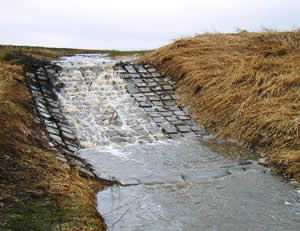Channel Grade Stabilization Structure

Description
A permanent structure used to drop water from a higher elevation to a lower elevation. Grade stabilization structures are used to reduce or prevent excessive erosion by reducing velocities in a watercourse or by providing channel linings or structures that can withstand high velocities.
Where Practice Applies
This practice applies to sites where earth and vegetation cannot safely handle water at permissible velocities, where excessive grades or overfall conditions are encountered, or where water is to be structurally lowered from one elevation to another. These structures should be planned and installed along with or as a part of other conservation practices in an overall surface water disposal system.
Planning Considerations
- Permanent grade stabilization structures may be constructed of concrete, metal, rock riprap, timber, or other suitable material. The choice of material is dependent on the proposed life of the structure, availability of materials, site specification, and soil conditions where the structure will be installed.
- Generally, concrete structures are more expensive and more complicated to build, however they are more durable. Prefabricated metal structures are avail- able at a slightly lower cost and are not as complicated to install. Rock riprap is a less expensive alternative where an adequate supply of durable rock is avail- able, but will require more maintenance. Timber structures are not as easily installed as rock riprap, nor are they as durable.
Design Recommendations
- Design and specifications should be prepared for each structure on an individual job basis by a qualified engineer.
- Overfall structures of concrete, metal, rock riprap, or other suitable material may be used to lower water from one elevation to another. These structures are applicable where it is desirable to drop the watercourse elevation over a very short horizontal distance.
- Adequate protection should be provided to prevent erosion or scour problems at both the upstream and downstream ends of the structure as well as along sides of the structure.
- Pipe drops of metal pipe may be used with suitable inlet and outlet structures. The inlet structure may consist of a vertical section of pipe, an embankment, or a combination of both. The outlet structure shall provide adequate protection against erosion or scour at the pipe outlet.
Capacity
- Structures which are designed to operate in conjunction with other erosion control practices should have as a minimum sufficient capacity to handle the bankfull capacity of the channel delivering water to the structure.
- The minimum design capacity for grade control structures that are not designed to per form in conjunction with other practices should be that required to handle a 25-year frequency 24-hour duration storm.
- Runoff values should be computed using accepted methods.
Maintenance
Grade stabilization structures should be checked at least annually and after every major storm. Concrete structures should be checked for concrete deterioration, settlement, and joint integrity. Pipe structures should be checked for deterioration of the pipe, settlement, and joint integrity. The outlets of the structures should be checked to see if the outlet is stable and is not eroding. If repairs are necessary, they should be made immediately to avoid further damage to the structures.
References
Minnick, E. L., and H. T. Marshall, Stormwater Management and Erosion Control for Urban and Developing Areas in New Hampshire, Rockingham County Conservation District, August 1992.